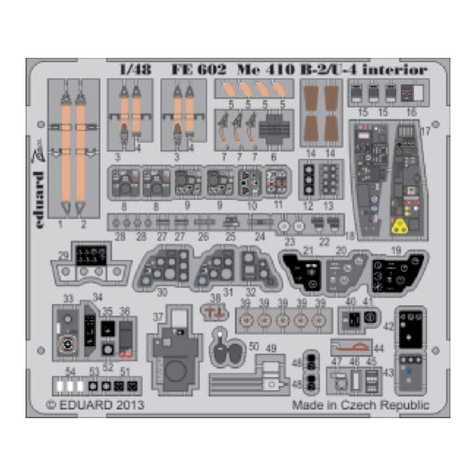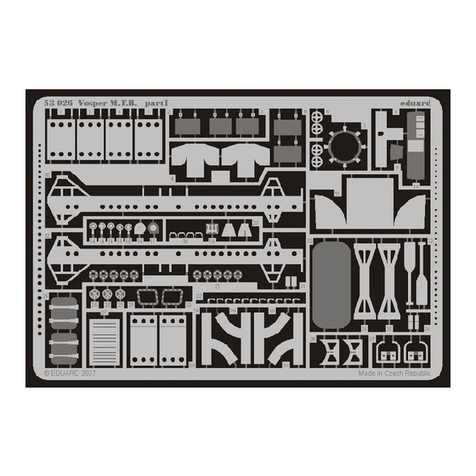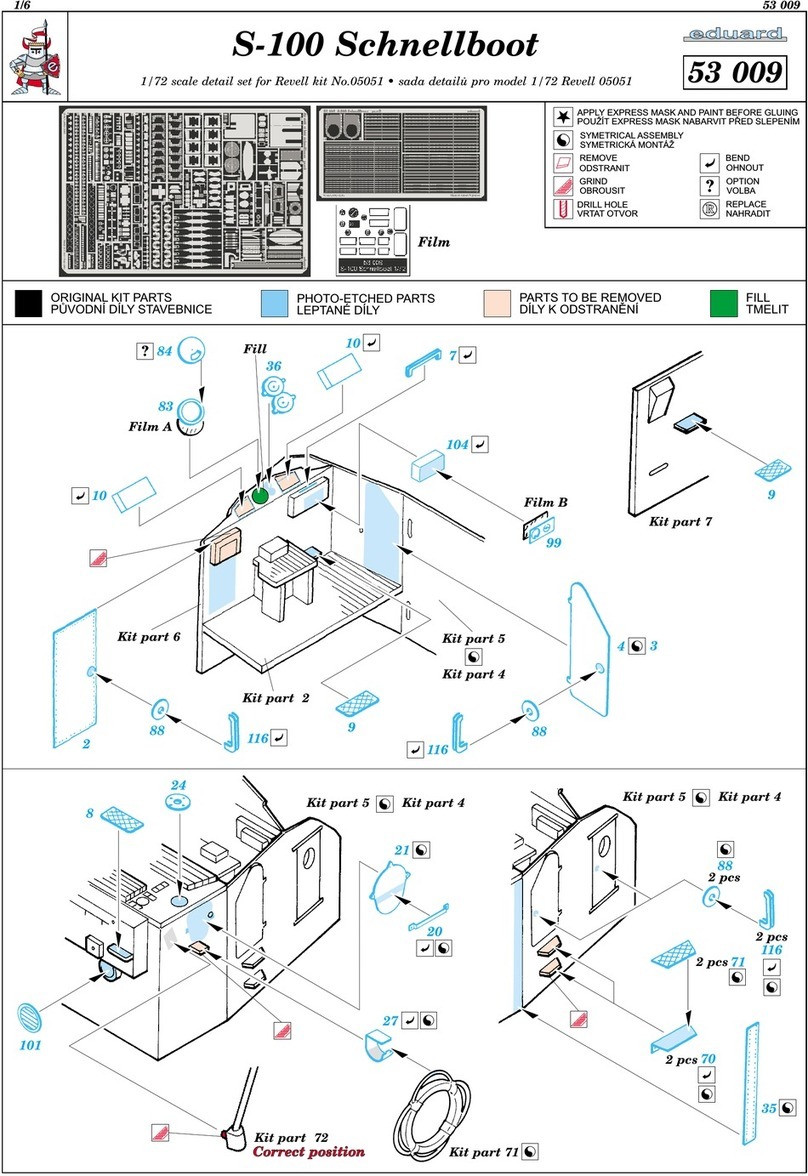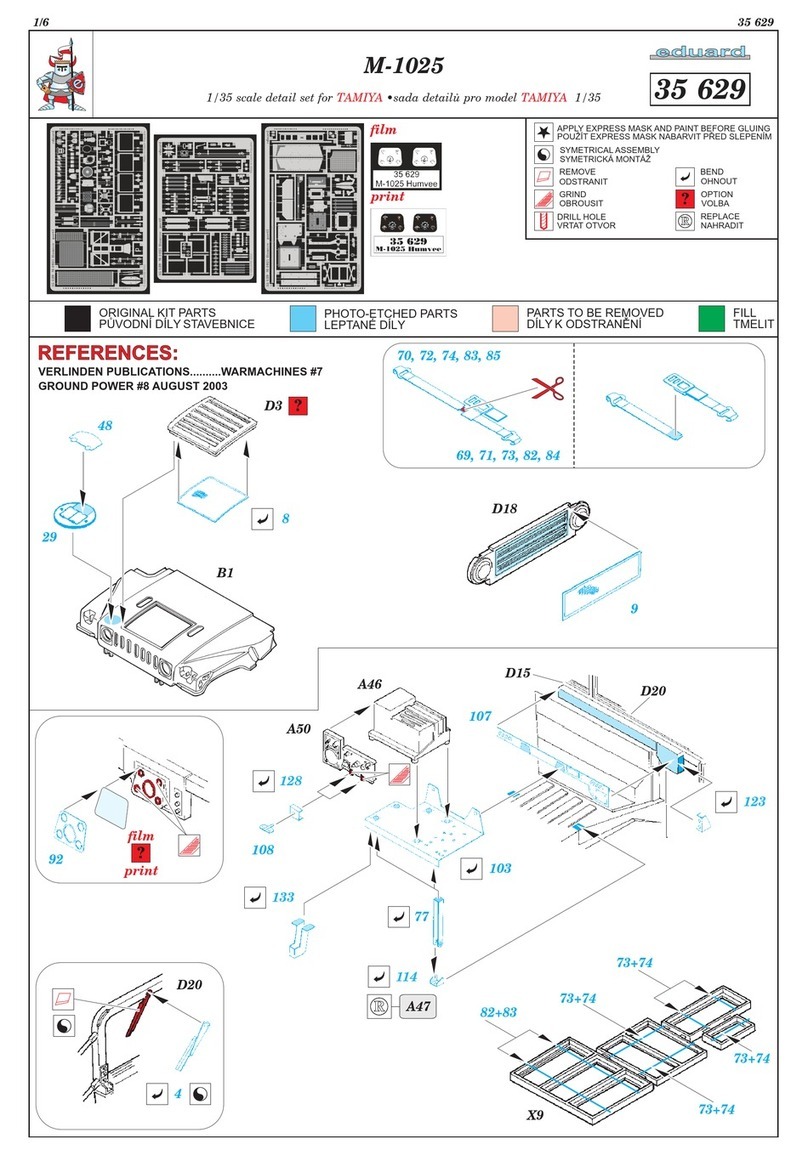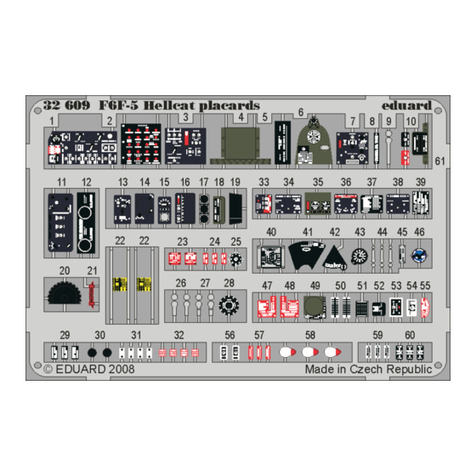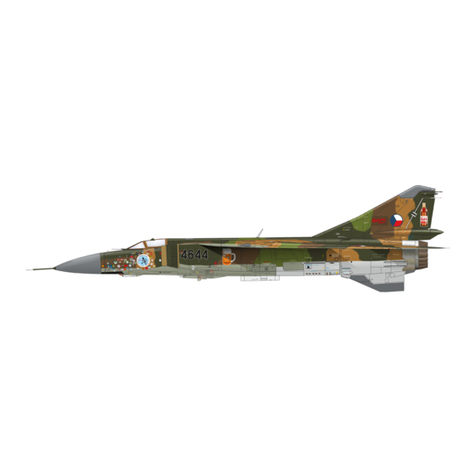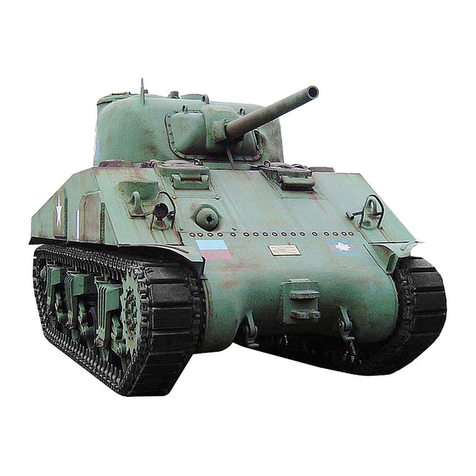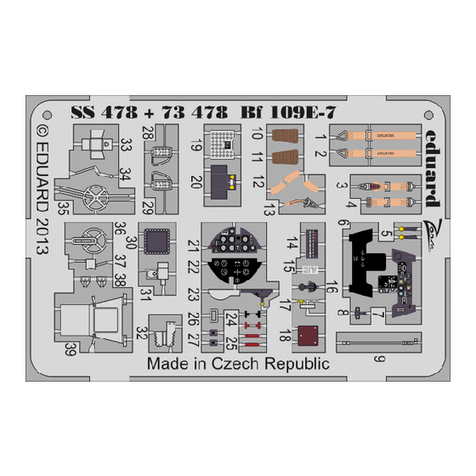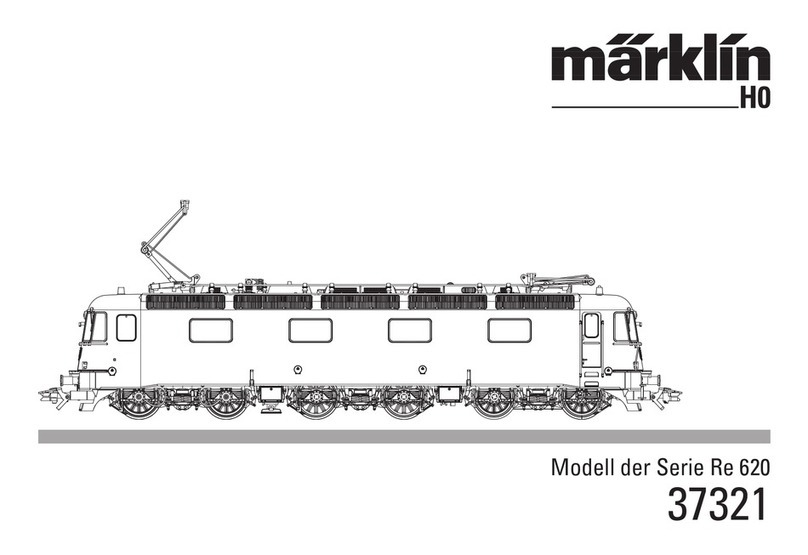intro
Spitfire Mk.IXc late version 8281
BRITISH WWII FIGHTER
1:48 SCALE PLASTIC KIT
In September 1941, a hitherto unknown German radial engine fighter appeared in the west European sky. The new airplane was superior
to British fighters, most distressingly to the Spitfire Mk.V. The German design was soon recognized as the Focke-Wulf Fw 190 A. The losses
suffered by the RAF over western Europe rose rapidly and the crisis was serious enough that the RAF ceased the majority of daytime operations
in November, 1941. The next attempt to resume these types of sorties was made in March 1942. Loss rates remained unacceptably high and the
RAF was forces to stop ops once again. All this was thanks to the Focke-Wulf Fw 190 A. The first response to the new German weapon was the
Spitfire Mk.VIII, but the design changes were so complex that initiating timely production was not possible. In June, 1942, a German pilot
landed by mistake on a British airfield delivering a completely intact Fw 190 fighter into RAF hands. Comparative trials between the Focke-
Wulf and Spitfire Mk.V began almost immediatelly. These mock encounters confirmed the situation over the front – the chances of a British
fighter surviving an encounter with the Fw 190 were slim. The only British fighter aircraft deemed suitable to oppose them were the Spitfire
Mk. VII and VIII powered by the Merlin 61 engine. As mentioned above these were some time away of being ready for series production. But
there was another way of getting a powerful fighter quickly - by mating the Merlin 61, with its two-stage supercharger, with the fuselage of the
Spitfire Mk.Vc. Two Mk.Vc airframes, AB196 and AB197, were selected for this purpose and were strengthened with modified longerons
to accommodate the more powerful and heavier engine. The example was finished on February 26 and the second on March 27, 1942. Flight
trials were succesful and the order for series production was issued almost immediately. Series production began in June 1942 and the first
Mk.IXs found their way to No. 64 Squadron in July. Performance improved significantly in comparison to the Mk.V. A top speed of 409 mph at
28,000 feet was higher by 40mph, and the service ceiling rose from 36,200 to 43,000 feet. The Mk.IX could climb at 4,000 feet per minute. The
RAF finally had a fighter aircraft capable of opposing the Fw 190 A. Three main versions of the Mk IX were produced. The F.IX was powered
by the Merlin 61 and was the only version on the assembly line in early 1943. The next version was the LF Mk.IX powered by the Merlin 66.
This engine was designed to do its best at low altitudes. The third version, manufactired along with the LF, was the high-altitude HF Mk.IX with
the Merlin 70. The majority of Mk.IXs manufactured were equipped with the so-called 'C' wing. Four 20mm cannon or two 20mm cannon and
four .303 machine guns could be installed in the wings. From 1944, the strengthened 'E' wing was produced. Four .303 machine guns were
replaced with two .50 heavy machine guns. Bomb racks for 250lb bombs were fitted under each wing typically. The Mk.IX became the second
most numerous version of the Spitfire with a total of 5653 examples being built. The Mk.IX began to replace the Mk.V from June, 1942. Thanks
to the new fighter, the RAF was ready to fight against the Luftwaffe over occupied Europe. Spitfire Mk.IXs served with the RAF to the end
of war. In the postwar era, foreign air forces flew this version as well. Czechoslovak, Norwegian, Danish, and Canadian air forces operated
numbers of Mk.IXs and they were not alone. Spitfires would find themselves in combat again. Czechoslovakia sold its Spitfire Mk.IXs to Israel
in 1948 and these aircraft formed the backbone of the newly born Israeli air force in the fight against their Arab neighbours.
V září 1941 se na evropské obloze objevil dosud neznámý německý stíhací letoun poháněný hvězdicovým motorem. Nová stíhačka měla nad
britskými, zejména Spitfirem Mk.V, zřetelnou převahu. V německé konstrukci byl záhy rozpoznán Focke-Wulf Fw 190 A. Ztráty RAF nad
západní Evropou začaly rychle narůstat až to té míry, že britské letectvo muselo v listopadu 1941 zastavit většinu denních operací nad
evropským kontinentem. Pokus o spuštění tohoto typu bojových letů byl uskutečněn v březnu 1942. Počty ztrát však byly opět neúnosné, což
opět vedlo k jejich zastavení. Vše díky Focke-Wulfům Fw 190 A. Prvním pokusem o odpověď na novou německou zbraň se stal Spitfire
Mk.VIII, avšak komplexní přístup ke změnám konstrukce letounu způsobil, že nebylo možné jej dostat do sériové výroby v dostatečně blízkém
časovém horizontu. V červnu 1942 přistál jeden z německých pilotů omylem na britském letišti a předal tak do britských rukou nepoškozený
Fw 190 A. Srovnávací zkoušky Focke-Wulfu a Spitfiru Mk.V začaly téměř neprodleně. Cvičné souboje plně potvrdily situaci na frontě – šance
britské stíhačky přestát setkání s Fw 190 bez úhony nebyly vysoké. Jediné britské stíhačky schopné postavit se plnohodnotně německému typy
byly Spitfiry Mk.VII a Mk.VIII poháněné motorem Merlin 61. Jak však bylo poznamenáno výše, nedalo se čekat, že v dohledné době dospějí
do fáze sériové výroby. Byla zde však ještě jedna cesta, jak získat dostatečně výkonnou stíhačku – zabudovat Merlin 61 s dvoustupňovým
kompresorem do základního draku Spitfiru Mk.V. Pro tento experiment byly vyčleněny dva draky, AB196 a AB197. Prošly zpevněním, aby
mohl být zastavěn výkonnější a těžší motor. První z nich byl dokončen 26. února, druhý pak 27. března 1942. Letové testy proběhly natolik
úspěšně, že byla objednána sériová výroba. Ta se plně rozběhla v červnu 1942 a první Mk.IX se u bojové jednotky, No. 64 Squadrony, objevily
v červenci. V porovnání s Mk.V se výkony znatelně zvýšily. Maximální rychlost byla v 28.000 stopách vyšší o 40 mph, operační dostup
se zvýšil z 36.200 na 43.000 stop. Mk.IX mohl stoupat rychlostí 4000 stop za minutu. RAF tedy konečně dostalo stíhačku, kterou mohlo směle
postavit proti Fw 190 A. Vyráběny byly tři hlavní verze Mk.IX. Verze F Mk.IX byla poháněna motorem Merlin 61 a z montážní linky sjížděla
až do počátku roku 1943. Na ni navázaly LF Mk.IX poháněná motorem Merlin 66 a určená k operacím v nižších výškách, a HF Mk.IX
s motorem Merlin 70 konstruovaným naopak pro výškové lety. Většina Mk.IX byla vyrobena s křídlem typu C. V něm mohla být instalována
výzbroj složená ze čtyř kanonů ráže 20 mm nebo ze dvou kanonů ráže 20 mm a čtyř kulometů ráže 0,303 palce. V roce 1944 se objevilo
zpevněné křídlo typu E. Čtveřice 0.303 kulometů byla nahrazena dvojicí kulometů ráže 0.50 palce. Pod každou polovinou křídla byly
standardně namontovány závěsníky pro 250lb pumy. Verze Mk.IX se stala druhou nejpočetnější verzí Spitfiru s 5653 vyrobenými kusy. Mk.IX
začaly nahrazovat Mk.V v červnu 1942. Díky nové stíhačce byla RAF opět schopná bojovat proti Luftwaffe nad okupovanou Evropou. Ve své
výzbroji si typ ponechala až do konce války. Po ukončení bojů se verze dostala i do výzbroje dalších letectev. Československé, norské, dánské,
kanadské a další letectva používala desítky Mk.IX. Spitfiry Mk.IX se však do bojů dostaly i v této době. Československo prodalo své Spitfiry
v roce 1948 do Izraele, kde se v bojích s arabskými sousedy staly páteřním typem nově vznikajících izraelských vzdušných sil.
úvodem
